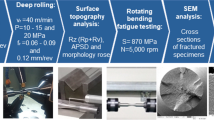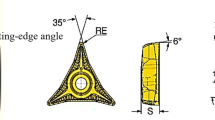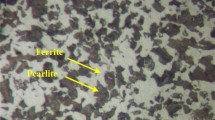Abstract
A number of manufacturing processes are able to plastically deform the work material and induce residual stresses in different ways, thus affecting the component surface integrity and, consequently, its ability to withstand cyclic loads. Besides the nature of the process, the parameters employed also have a significant influence on the fatigue strength. This work investigates the influence of the turning parameters and deep rolling on the surface roughness, fatigue life, and fatigue fracture of hardened AISI 4140 steel. Fatigue specimens were turned under various cutting speeds, feeds, and depths of cut and further subjected to deep rolling under a constant condition. The results indicated that deep rolling was able to reduce all the roughness amplitude parameters investigated. Regarding the fatigue life of the turned specimens, there was a combined influence of feed and depth of cut, i.e., for the lower feed (0.2 mm/rev), an increase in depth of cut from 0.5 to 1.0 mm promoted an increase in fatigue life; however, the opposite occurred for the higher feed value (0.3 mm/rev). This behavior was more pronounced at higher cutting speeds. Deep rolling increased the fatigue life of the specimens, but a higher number of cycles were applied before the fracture of the specimens turned using the higher feed value, thus suggesting that deep rolling is not be able to completely eliminate the influence of previous turning on the surface integrity.

















Similar content being viewed by others
Availability of data and material
Not applicable.
Code availability
Not applicable.
References
Astakhov VP (2010) Surface integrity – definition and importance in functional performance. In: Davim JP (ed) Surface integrity in machining. 1. ed. London: Springer, p 1–25. https://doi.org/10.1007/978-1-84882-874-2_1
Bhat S, Patibandla R (2011) Metal fatigue and basic theoretical models: a review, Alloy steel - properties and use, Dr. Eduardo Valencia Morales (Ed.), ISBN: 978-953-307-484-9, InTech, p 203–246. https://doi.org/10.5772/28911
Muñoz-Cubillos J, Coronado JJ, Rodríguez AS (2017) Deep rolling effect on fatigue behavior of austenitic stainless steels. Int J Fatigue 95:120–131. https://doi.org/10.1016/j.ijfatigue.2016.10.008
Milella PP (2013) Fatigue and corrosion in metals. Springer, p 844. https://doi.org/10.1007/978-88-470-2336-9
Chomienne V, Verdu C, Rech J, Valiorgue F (2013) Influence of surface integrity of 15–5PH on the fatigue life. Procedia Eng 66:274–281. https://doi.org/10.1016/j.proeng.2013.12.082
Javidi A, Rieger U, Eichlseder W (2008) The effect of machining on the surface integrity and fatigue life. Int J Fatigue 30:2050–2055. https://doi.org/10.1016/j.ijfatigue.2008.01.005
Rech J, Moisan A (2003) Surface integrity in finish hard turning of case-hardened steels. Int J Mach Tools Manuf 43:543–550. https://doi.org/10.1016/S0890-6955(02)00141-4
Meddour I, Yallese MA, Bensouilah H, Khellaf A, Elbah M (2018) Prediction of surface roughness and cutting forces using RSM, ANN, and NSGA-II in finish turning of AISI 4140 hardened steel with mixed ceramic tool. Int J Adv Manuf Technol 97:1931–1949. https://doi.org/10.1007/s00170-018-2026-6
Das SR, Dhupal D, Kumar A (2015) Study of surface roughness and flank wear in hard turning of AISI 4140 steel with coated ceramic inserts. J Mech Sci Technol 29(10):4329–4340. https://doi.org/10.1007/s12206-015-0931-2
Cakan A, Evrendilek F (2017) Multivariate empirical modeling of interaction effects of machining variables on surface roughness in dry hard turning of AISI 4140 steel with coated CBN insert using Taguchi design. Mechanika 23(5):756–761. ISSN 1392-1207. https://doi.org/10.5755/j01.mech.23.5.16223
El-Axir MH, Elkhabeery MM, Okasha MM (2017) Modeling and parameter optimization for surface roughness and residual stress in dry turning process. Eng Technol Appl Sci Res 7(5):2047–2055. https://doi.org/10.48084/etasr.1560
Rami A, Kallel A, Sghaier S, Youssef S, Hamdi H (2017) Residual stresses computation induced by turning of AISI 4140 steel using 3D simulation based on a mixed approach. Int J Adv Manuf Technol 91:3833–3850. https://doi.org/10.1007/s00170-017-0047-1
Jacobus K, Devor RE, Kapor SG, Peascoe RA (2001) Predictive model for the full biaxial surface and subsurface residual stress profiles from turning. J Manuf Sci Eng 123:537–546. https://doi.org/10.1115/1.1372197
Abrão AM, Denkena B, Koehler J, Breidenstein B, Moerke T (2015) The inducement of residual stress through deep rolling of AISI 1060 steel and its subsequent relaxation under cyclic loading. Int J Adv Manuf Technol 79:1939–1947. https://doi.org/10.1007/s00170-015-6946-0
Pawade RS, Joshi SS, Brahmankar PK (2008) Effect of machining parameters and cutting edge geometry on surface integrity of high-speed turned Inconel 718. Int J Mach Tools Manuf 48:15–28. https://doi.org/10.1016/j.ijmachtools.2007.08.004
Sharman ARC, Hughes JI, Ridgway K (2015) The effect of tool nose radius on surface integrity and residual stresses when turning Inconel 718. J Mater Process Technol 216:123–132. https://doi.org/10.1016/j.jmatprotec.2014.09.002
Lopes KSS, Sales WF, Palma ES (2008) Influence of machining parameters on fatigue endurance limit of AISI 4140 steel. J Braz Soc Mech Sci Eng 1:77–83. https://doi.org/10.1590/S1678-58782008000100011
Bannantine JA, Comer JJ, Handrock JL (1989) Fundamentals of metal fatigue analysis. Prentice Hall, Englewood Cliffs, ISBN: 978-0133401912
Hassani-Gangaraj SM, Carboni M, Guagliano M (2015) Finite element approach toward an advanced understanding of deep rolling induced residual stresses, and an application to railway axles. Mater Des 83:689–703. https://doi.org/10.1016/j.matdes.2015.06.026
Altenberger I (2005) Deep rolling – the past, the present and the future. Int Conf Shot Peen 144–155
Saritha P (2014) A study on assessment of theories for contact stress distribution at roller-work piece contact in roller burnishing. Int J Sci Eng Technol Res (IJSETR) 3(1):100–106
Regazzi D, Beretta S, Carboni M (2014) An investigation about the influence of deep rolling on fatigue crack growth in railway axles made of a medium strength steel. Eng Fract Mech 131:587–601. https://doi.org/10.1016/j.engfracmech.2014.09.016
Majzoobi GH, Jouneghani FZ (2016) Khademi E (2016) Experimental and numerical studies on the effect of deep rolling on bending fretting fatigue resistance of Al7075. Int J Adv Manuf Technol 82:2137–2148. https://doi.org/10.1007/s00170-015-7542-z
Asmaa TM, Kesba MM, Abu-gharbia F (2019) Ball burnishing of internal turned surfaces. J Egypt Soc Tribol 16(1):33–43
Prabhu PR, Kulkarni SM, Sharma SS, Jagannath K, Kini A (2015) Analysis of surface hardness, surface roughness, and near surface microstructure of AISI 4140 steel worked with turn-assisted deep cold rolling process. Int J Mech Mechatr Eng 9(6):1070–1076
Prabhu PR, Kulkarni SM, Sharma SS (2020) Multi-response optimization of the turn-assisted deep cold rolling process parameters for enhanced surface characteristics and residual stress of AISI 4140 steel shafts. J Market Res 9(5):11402–11423. https://doi.org/10.1016/j.jmrt.2020.08.025
Avilés R, Albizuri J, Rodríguez A, De Lacalle LL (2013) Influence of low-plasticity ball burnishing on the high-cycle fatigue strength of medium carbon AISI 1045 steel. Int J Fatigue 55:230–244. https://doi.org/10.1016/j.ijfatigue.2013.06.024
International Organization for Standardization (1996) Geometrical Product Specifications (GPS) — Surface texture: Profile method — Rules and procedures for the assessment of surface texture (Standard No. 4288:1996)
Funding
The research leading to these results received funding from the Coordination for the Improvement of Higher Education Personnel—Brazil (CAPES) under Grant Agreement Code 001.
Author information
Authors and Affiliations
Corresponding author
Ethics declarations
Ethics approval
Not applicable.
Consent to participate
Not applicable.
Consent for publication
The authors give full consent to the publisher for the publication of this work.
Competing interests
The authors declare no competing interests.
Additional information
Publisher's Note
Springer Nature remains neutral with regard to jurisdictional claims in published maps and institutional affiliations.
Rights and permissions
About this article
Cite this article
Martins, A.M., Rodrigues, P.C.M. & Abrão, A.M. Influence of machining parameters and deep rolling on the fatigue life of AISI 4140 steel. Int J Adv Manuf Technol 121, 6153–6167 (2022). https://doi.org/10.1007/s00170-022-09703-1
Received:
Accepted:
Published:
Issue Date:
DOI: https://doi.org/10.1007/s00170-022-09703-1




